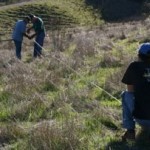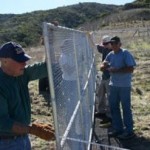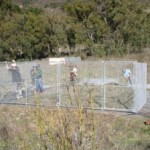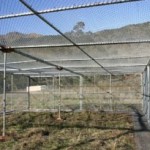An L.A. Times article today on the excellent success of the island fox captive breeding program on Santa Rosa Island reminded me that in a few days it will be the fourth anniversary of my trip to Santa Rosa’s neighbor Santa Cruz Island with a team of fellow Los Angeles Zoo docents.
Invited by The Nature Conservancy to help build pens there for the expansion of its captive breeding program, we spent the better part of four days in the island’s interior (normally off-limits to outsiders) working on the slopes of a small valley near the historic and ridiculously picturesque Stanton Ranch erecting four 600-square-foot pens where the remaining housecat-sized wild foxes would be caught up and installed to better ensure their safety, increase their drastically low numbers, and ultimately enable their survival.
Historical nutshell time! The foxes lived perfectly on the Channel Islands with bald eagles and mice and blue jays and bugs and native human inhabitants for as much as 16,000 years, but that all began to change when between 1947 and 1971 some 1,800 tons of DDT and an unknown amount of PCBs were dumped in Torrance, making its way through sewer lines into the bay near Palos Verdes where it spread. Bald eagles on the islands eventually ate fish tainted with the pesticide and died off, and in their place came opportunistic golden eagles from the mainland, with a far greater taste for flesh than fish. With no baldies to harrass them, the golden eagle couldn’t help but thrive by exploiting unchecked a virtually endless food supply in the expanding populations of feral pigs–Â an ecologically disastrous byproduct of the farming and ranching that took place on Santa Cruz for more than 150 years. The golden eagle wasn’t picky and would gladly eat island foxes, too. And as if the eagles weren’t enough of a threat, the pigs contributed by basically rooting up much of the native vegetation, thereby both reducing the food available to the fox and also leaving them few places to hide and escape the eagles. Seriously, by 1994 when the animal was listed as an endangered spicies there were populations of foxes on some islands that barely numbered in the double digits. In the course of the recovery effort that began in the late 1990s, the golden eagles have been trapped and relocated, bald eagles have been successfully reintroduced, and the pigs — some 5,000 of them — have been killed off.
With my departure from the zoo a year after my visit to Santa Cruz Island, I confess I haven’t been keeping as abreast of the island fox recovery efforts these past few years. So it came as a surprise to learn that the captive breeding program has been so successful that the pens we built have actually been closed since last year – and for good reason: they’re just no longer needed.
In 2004, there were less than 60 foxes on Santa Cruz island. Now it’s estimated that there are more than 400 — and growing. Populations on Santa Rosa, San Miguel and other islands in the Channel chain are also on the rise.
Though the part that I didn’t hesitate to play in that complex and successful process was infinitesimally small, the amount of pride I take in it is huge.
A photobook I made of images from the excursion can be viewed here on Shutterfly. Or the full photo album can be seen here.




 Follow
Follow